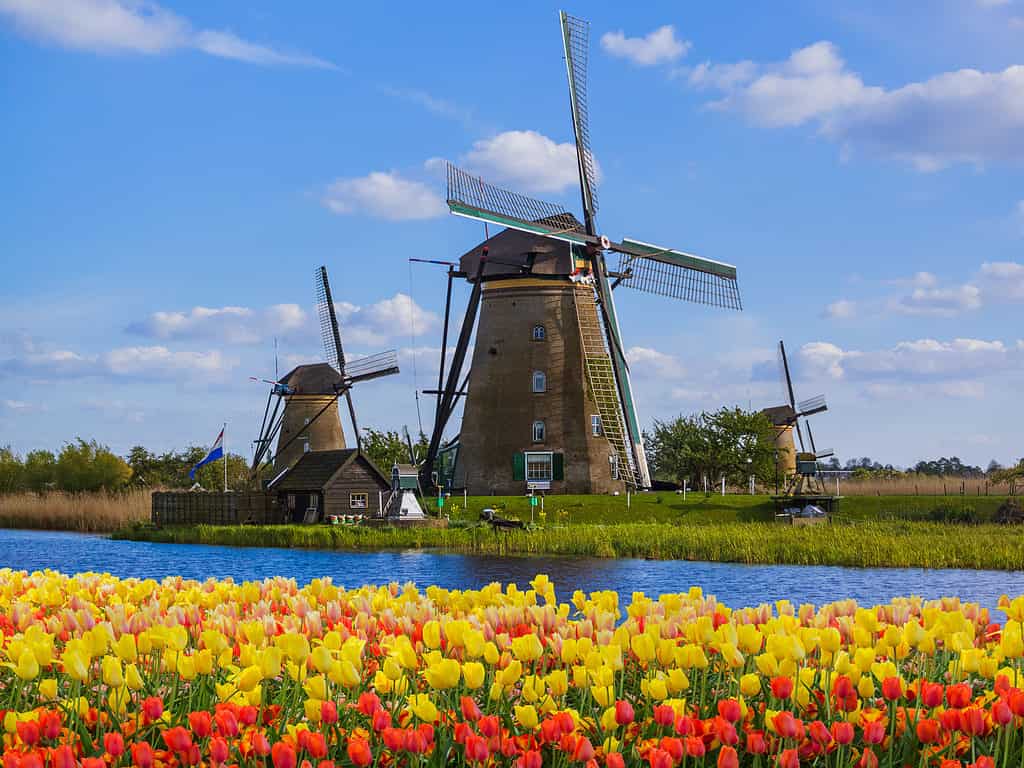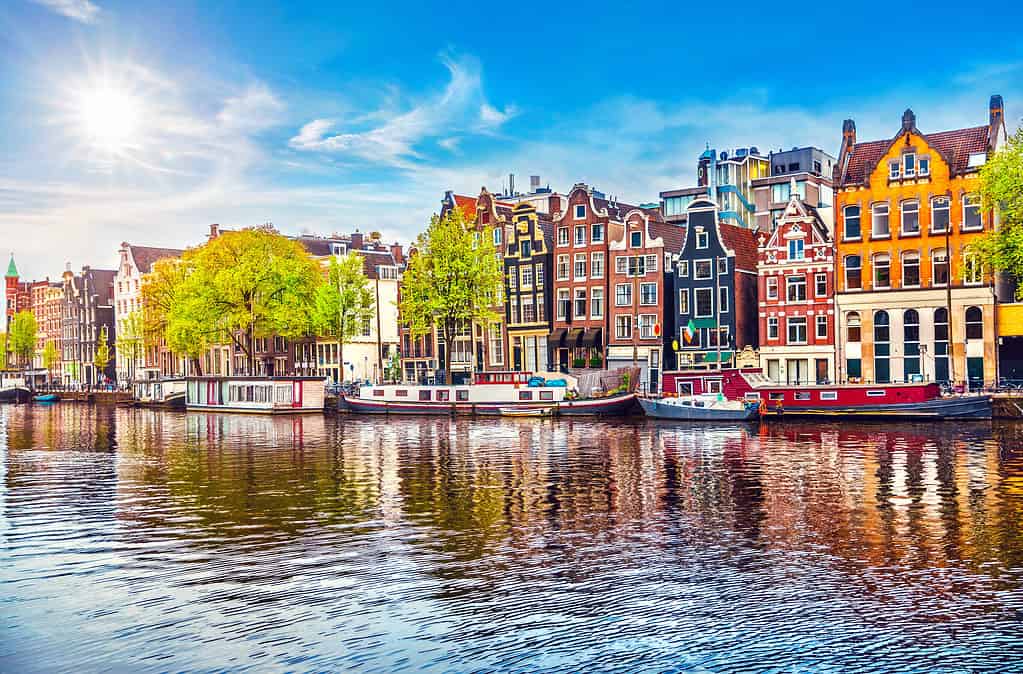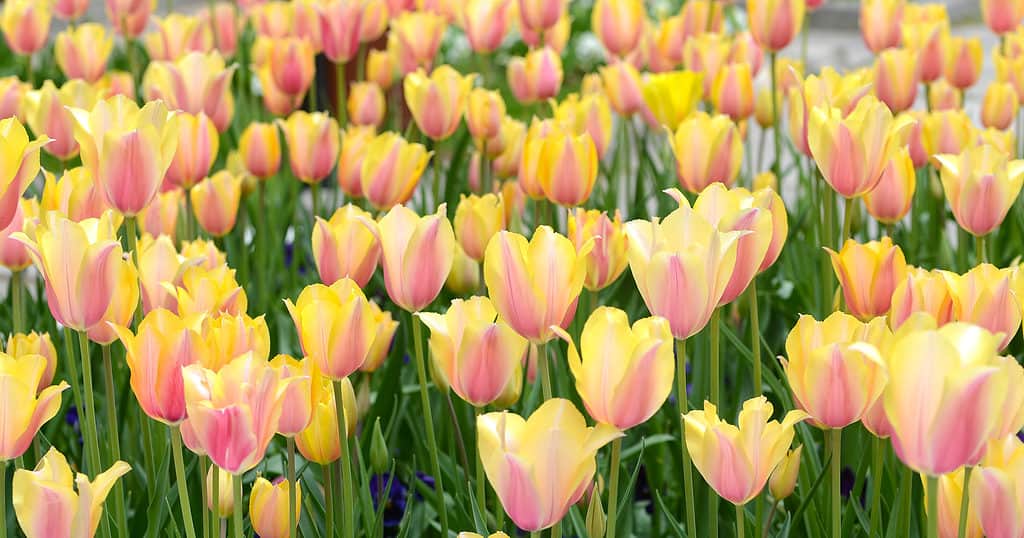The Netherlands is best known for windmills, wooden clogs, and vast tulip fields, so it’ll be no surprise to hear it’s Holland’s national flower. Let’s discover the national flower of The Netherlands: the tulip.
What Is The National Flower of The Netherlands?
The national flower of the Netherlands is the tulip, but this is not official. Over the centuries, tulips have been synonymous with The Netherlands, so it’s an unofficial, but one that most people would recognize as the national flower.
The official symbol for the Netherlands is a golden lion with a crown, sword, and arrows. It is called the Dutch Lion and appears on the Netherlands’ Coat of Arms.
Where is the Netherlands?

Windmills and flowers in the Netherlands.
©iStock.com/TPopova
The Kingdom of the Netherlands is a twelve-province country bordering Germany, Belgium, and the North Sea in northwestern Europe. It’s also called Holland, although this is really the name of a large province in its European land mass.
The Netherlands is the largest country in the Kingdom of the Netherlands and is home to 17.7 million people. The other constituent countries are Aruba, Curacao, and Saint Maarten, all territories situated in the mid-south Caribbean sea.
Dutch is the Netherlands’ official language, its capital is Amsterdam, and King Willem-Alexander is currently the King. The Netherlands means “lower countries” because it’s pretty much flat. Only 50% of its landmass is 3.3 feet above sea level. The rest is below sea level!
Is it Holland or The Netherlands?

©Yasonya/Shutterstock.com
The country’s official name is the Kingdom of the Netherlands, and Holland only refers to two provinces called Noord Holland and Zuid Holland (north and south).
Some people use the name Holland to refer to all of the Netherlands because historically, the Holland provinces used to make the biggest economic contribution.
And Dutch? That’s the language spoken in the Netherlands.
Discover Why the National Flower of the Netherlands is the Tulip
Tulips aren’t native to the Netherlands, so how did they become the national flower?
In the 1500s, the Ottoman Empire ruled much of the area we now know as Turkey, Hungary, and further into eastern Asian areas. The emperor’s favorite flower was a tulip, and bulbs were given as exotic royal gifts to western diplomats.
Tulips made their way back to Europe, and those planted in the Netherlands grew quickly due to their highly fertile soil. Before long, tulips became the most sought-after commodity in the Netherlands.
You may have heard about tulip mania which occurred in the Dutch golden age between 1634 and February 1637. During this time, tulips were the focus of a speculative bubble in Holland and traded at ever-increasing prices. There are reports of one tulip bulb exchanged for acres of land!
The speculative bubble burst in 1637 because buyers couldn’t afford the high prices, but since then, tulips have grown and been traded in the Netherlands.
You can still see kilometers of tulips in bloom there today. Visit Holland from April to May, and see Keukenhof Park. Seven million tulip bulbs are planted every year. It’s a vast rainbow of flower power and quite astonishing to see.
All About Tulips

Field filled with yellow and pink Blushing Lady Tulips in bloom
©Artography/Shutterstock.com
Tulips are native to Turkey and Asia. Historians think the Persians first cultivated them in 1055. Tulips didn’t arrive elsewhere until the Ottoman empire took them to Hungary, and from there, they spread across Europe.
These beautiful flowering plants are spring bulbs that emerge in early spring and die back to the bulb in late spring (depending on their species).
Around 75 naturally occurring tulips grow natively from central Asia to southern Europe on mountains and steppes. Still, thousands of new cultivars have been bred over the past centuries.
With a few exceptions, tulips belong to the Lilieae family, but experts have struggled to classify them because there are so many different types.
Tulip Flowers
Tulips are stunning flowers that put all their energy into spectacular blooms.
Flowers are bright, showy blooms of red, yellow, purple, orange, and white, but plant breeders offer more colors every year. There are striped, spotted, ruffled, frilly, and multi-colored tulips.
Tulips have a minimum of four to six petals, but rare bulbs produce up to 12 petals.
Tulip flowers have two unusual features:
- A blotch of different color always appears near the stamens. Experts think this helps guide pollinators.
- Their lack of scent. In the 1600s, Dutch tulip lovers associate their lack of scent with chasteness! Today, hay fever sufferers love them for their low pollen count.
The lack of scent doesn’t put off pollinators, though. Bees, hoverflies, and other beneficial insects flock to tulip blooms, especially the early flowering varieties that provide much-needed early-season nectar.
Is There a Blue Tulip?
Despite ongoing attempts, no breeder has ever produced a blue tulip!
Recently an almost black tulip emerged called Queen of the Night. It’s very dark, but not quite black. It’s described as a deep purple maroon.
Tulip Foliage
Tulip foliage is long, strappy, and mid-green. The leaves are coated in a fine layer of wax that helps protect them from insect attacks and poor weather. The foliage doesn’t vary much between species and cultivars. Breeders have been concentrating their efforts on their flowers!
How Big Do Tulips Get?
The smallest dwarf tulips start at around six inches tall, and giant cultivars reach 26 inches. They are tall and thin with little foliage, so they take up little horizontal space.
How To Grow Tulips

Blooming red and yellow Banja Luka tulips
©Liviu Gherman/Shutterstock.com
In their native lands, tulips thrive in cold winters and warm summers. You need to replicate this pattern to get the best from your tulips. That means USDA zones 8 and above, plus hot tropical countries, will need to put in the extra effort.
Tulips are bulbs, so once planted, they can be left to grow for years, but after a few seasons, they tend to lose their vibrancy. Many gardeners dig up tulips after two to three years and replace them with fresh new bulbs.
Here’s how to grow tulips:
- Plant bulbs in late fall, so they have time to bloom in early spring. Place bulbs eight inches deep with the pointy end upwards.
- You can plant them close together because they grow vertically. Don’t be afraid to pack them in. A thick patch of tulips is always better looking than a few spaced out.
- Use rich soil. Tulips love moist, nutrient-rich growing matter. Bulge it up with well-rotted organic matter or compost if yours is a bit thin.
- Once planted, cover them with mulch to prevent waterlogging. Alpine stone works well on pot tops. In a large border, wood chippings are a good alternative. Be sure to put pots on bricks so excess water can drain away.
- Depending on their species, tulips flower from early to late spring.
- Don’t clear away spent tulip foliage. Let it rot down to feed the bulb.
In USDA Zones 8 and Above
USDA 8 and above, plus tropical climates, will always find it hard to grow tulips because they become heat stressed. Their native origins mean tulips are naturally in need of a cold spell.
Replicate this by digging up tulip bulbs after their foliage has rotted away. Store them somewhere cool and dark, then two months before planting out, put them in the refrigerator to mimic a cold winter. This will stimulate growth!
Beautiful Tulips are the Netherlands’ National Flower
Let’s discover the national flower of the Netherlands. The tulip had an interesting ride through history and botany. It’s almost impossible to separate the two, especially in the Netherlands!
The tulip mania frenzy certainly ensured we will always associate Holland with beautiful tulips.
If you can go there in spring, you’ll see tulips everywhere! It’s an incredible sight; no wonder the Netherlands’ national flower is the glorious tulip.
Up Next
- The Flag of The Netherlands: History, Meaning and Symbolism
- 3 Tulips that Thrive in Ohio
- Tulips in Texas: Types and When they Bloom
The photo featured at the top of this post is © Yasonya/Shutterstock.com
Thank you for reading! Have some feedback for us? Contact the AZ Animals editorial team.






